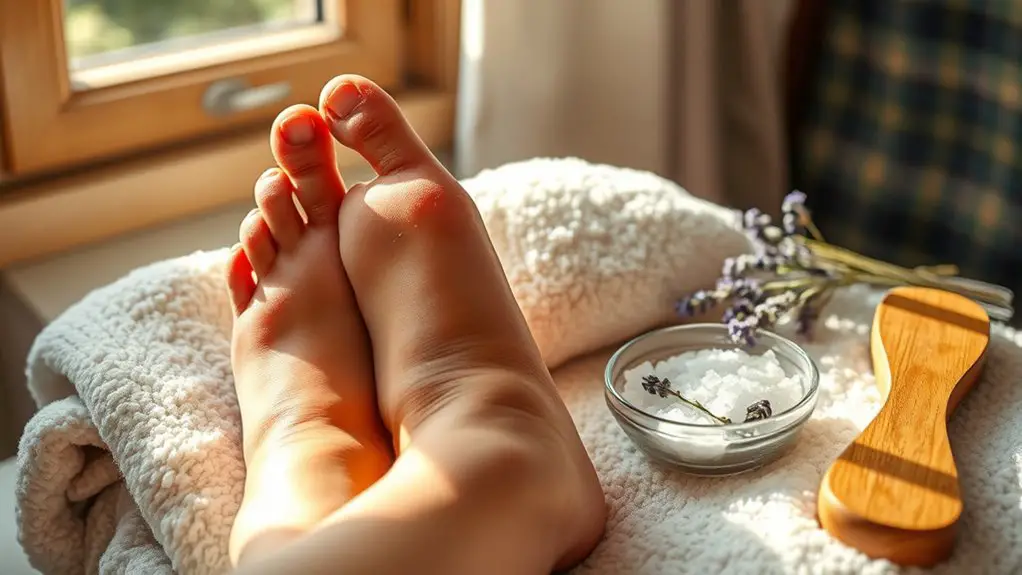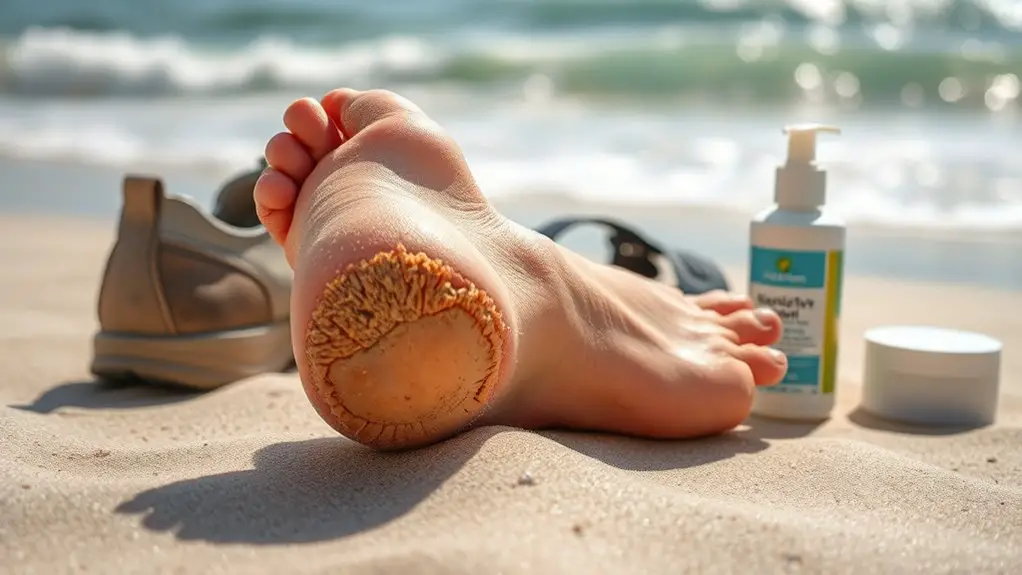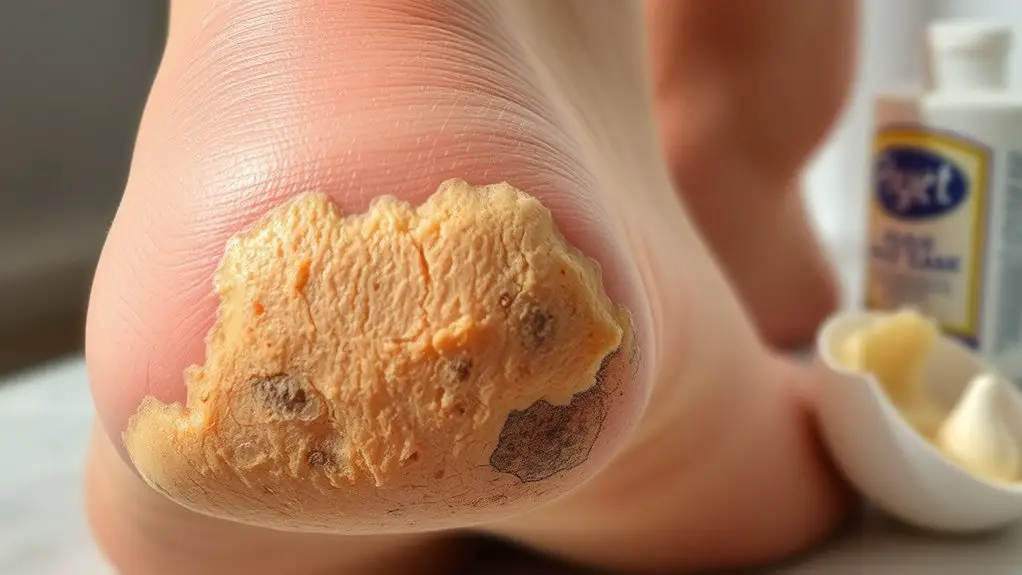Heel calluses form mainly due to repeated friction and pressure, often exacerbated by ill-fitting shoes or prolonged standing. Genetic factors, foot structure, and lack of proper support can increase your risk. To treat them, you can use natural exfoliants, soak your feet in warm water, and apply thick moisturizers regularly. If calluses persist, professional treatments like debridement or custom orthotics may be effective. Discovering more about prevention can help you maintain healthier, smoother feet.
Understanding the Causes of Heel Calluses

Although heel calluses might seem like a minor annoyance, understanding their causes is essential for effective treatment and prevention. Calluses form when the skin experiences repeated friction or pressure, leading to an increase in skin thickness as it tries to protect itself. This causes a buildup of dead skin cells, resulting in those rough patches you may notice on your heels.
A causes overview reveals that factors such as ill-fitting shoes, prolonged standing, or certain activities can exacerbate this issue. When your feet aren’t adequately cushioned, the skin responds by thickening to defend against irritants. Additionally, conditions like flat feet or high arches can contribute to uneven pressure distribution, intensifying callus formation. Recognizing these underlying causes is the first step toward addressing heel calluses effectively and ensuring your feet remain healthy and comfortable.
Risk Factors for Developing Heel Calluses
Several factors can increase your likelihood of developing heel calluses, often compounding the issues caused by the underlying conditions discussed earlier. One significant risk factor is your genetic predisposition; if your family has a history of calluses or other foot issues, you might be more prone to experiencing similar problems. Additionally, your footwear choices can greatly affect your risk. Wearing shoes that lack proper arch support or have tight-fitting heels can lead to increased friction and pressure on your heels, promoting callus formation. High heels or flip-flops, for instance, can exacerbate the situation. It’s also important to take into account your daily activities; standing for prolonged periods or engaging in sports without appropriate footwear can increase your likelihood of developing calluses. By being aware of these risk factors, you can take proactive steps to minimize your chances of developing heel calluses in the future.
At-Home Remedies for Heel Calluses

If you’re dealing with heel calluses, there are several effective at-home remedies that can help alleviate discomfort and promote healthier skin. One of the best methods is natural exfoliation. You can create a simple scrub using a mixture of sugar and olive oil. Gently massage this onto your heels to slough off dead skin cells. Alternatively, soaking your feet in warm water mixed with Epsom salts for about 15-20 minutes can soften calluses, making them easier to remove.
After exfoliation, it’s essential to follow up with moisturizing treatments. Use a thick cream or lotion containing ingredients like shea butter or urea to deeply hydrate your feet. Applying this moisturizer before bed and wearing cotton socks overnight can greatly enhance the healing process. Regularly incorporating these remedies into your routine can help manage heel calluses and keep your skin smooth and healthy.
Professional Treatment Options
When home remedies aren’t enough to manage heel calluses effectively, exploring professional treatment options can provide significant relief and long-lasting results. Podiatric interventions are often the best approach for stubborn calluses. A podiatrist can assess your foot structure and recommend tailored treatments, such as custom orthotics, to alleviate pressure points that contribute to callus formation.
One advanced option is laser therapy, which uses focused light to precisely remove excess skin without damaging surrounding tissues. This procedure is minimally invasive and can promote faster healing compared to traditional methods. Additionally, a podiatrist may perform gentle debridement, safely removing thickened skin while reducing pain and discomfort.
Ultimately, seeking professional help not only addresses existing calluses but also helps prevent future issues by identifying underlying causes. Don’t hesitate to consult a specialist for effective and lasting solutions to your heel calluses.
Preventive Measures to Avoid Heel Calluses

To effectively prevent heel calluses, it is vital to focus on proactive measures that minimize friction and pressure on your feet. Wearing proper footwear is critical; choose shoes that offer cushioning and support while allowing your feet to breathe. Additionally, maintaining good foot hygiene can help keep your skin healthy and reduce the likelihood of calluses forming.
Here’s a table summarizing key preventive measures:
| Measure | Description | Benefits |
|---|---|---|
| Proper Footwear | Select shoes with cushioning and support | Reduces pressure and friction |
| Moisturize | Apply lotion to keep skin hydrated | Softens skin, prevents dryness |
| Regular Exfoliation | Gently scrub callused areas | Removes dead skin, promotes renewal |
| Foot Hygiene | Wash and dry feet daily | Prevents infections, maintains skin health |
Frequently Asked Questions
Can Heel Calluses Lead to Other Foot Problems?
Yes, heel calluses can lead to other foot problems. Callus formation often alters your foot’s biomechanics, increasing pressure on different areas, potentially resulting in pain, blisters, or even conditions like plantar fasciitis, affecting overall foot health.
Are Certain Shoes Better for Preventing Heel Calluses?
Yes, certain shoes can help prevent heel calluses. Look for shoe materials that are breathable and supportive, and make sure they provide adequate arch support. This combination reduces friction and pressure on your heels, minimizing callus formation.
Is It Safe to Remove Calluses at Home?
Is it safe to remove calluses at home? Sure, if you’re careful! Using proper callus removal tools and home remedies like pumice stones can be effective, but always avoid overly aggressive methods to prevent injury.
How Often Should I Moisturize to Prevent Calluses?
To prevent calluses, you should incorporate moisturizing into your daily routines. Aim for at least once a day to enhance skin hydration, ensuring your heels remain soft and less prone to developing thickened skin.
Do Heel Calluses Indicate a Health Condition?
Heel calluses don’t necessarily indicate a serious health condition, but they can reflect poor heel health or underlying skin conditions. Regular assessment and proper foot care can help maintain healthy skin and prevent complications.



